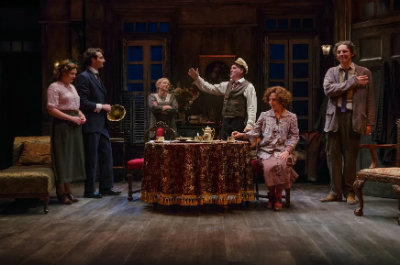Juno and the Paycock

(Left to Right) Mary Mallen, James Russell, J. Smith-Cameron, Ciarán O’Reilly, Terry Donnelly, John Keating.
Photo by James Higgins.
BOTTOM LINE: A seminal Irish play done justice by New York's seminal Irish theatre.
First staged at the Abbey Theatre in Dublin in 1924, Sean O’Casey’s examination of the domestic impact of the Irish Civil War is now one of the pivotal works of modern Irish drama. It’s been over 15 years since Juno and the Paycock played at New York’s Irish Repertory Theatre, and it has happily returned in a lively production staged by artistic director Charlotte Moore. This follow-up to last season’s stellar production of The Weir does not disappoint.
Set amidst an impoverished tenement household in 1922 Dublin, O’Casey’s play masterfully toggles the line between comedy and tragedy. Moore boldly shifts gears between the two styles seamlessly. The cast is excellent as a whole, but it is J. Smith-Cameron as the titular Juno who galvanizes the parade of characters with a deeply human performance.
O’Casey sets his portrait of a family caught in revolutionary turmoil in the home of Juno Boyle and her drunken deadbeat of a husband “Captain” Jack Boyle (played charismatically by Ciarán O’Reilly). Constantly avoiding work due to fictitious claims of ailments and injuries, he wastes away the family’s money and dignity drinking with his old friend Joxer (John Keating). Rather than deal with politics and the horrors on his doorstep he pines away with Joxer philosophizing “what is the moon, what is the stars?”
The effects of Jack’s vices are evident in the hardship and neglect of his two children, Mary (a welcome and grounded portrayal by Mary Mallen) and Johnny (Ed Malone). When an English solicitor, Charlie Bentham (a charming James Russell), arrives with news of an inheritance, Jack springs into full health and promptly purchases grossly lavish furnishing and clothing on credit. When Joxer inquires about how life has changed after coming into money, Jack responds solemnly “It’s a responsibility, Joxer, a great responsibility.” Entirely out of his element he assumes his perceived role of wealth.
Charlie also promptly begins courting Mary. Of the entire Boyle family, Mary has the best shot of escaping the lower class and entering into refinement. Juno is aware of her potential, and of her son Johnny’s deterioration into madness and despair after first losing his arm in the rebellion, and then now facing accusations of betrayal against the Republic. Johnny sees the inheritance as a possibility of escape from his past, “We’ll be able to get out o’ this place now, an’ go somewhere we’re not known.” Even Juno is taken by the good fortune as they celebrate through music and dance, shuttering their eyes to the funeral of a neighbor’s son.
Jack’s hubris gets the better of him as the inheritance proves to have some holes in it. Johnny’s inability to escape grows to be dangerous as ghosts of his past return to haunt him. Mary’s relationship with Charlie threatens her future and Jack spirals downward again returning to his old ways with Joxer. All of this culminates in the need for Juno to make a decision on how to protect her family from, as Jack famously puts it, “a state o’ chassis.”
Set designer James Noone fully envelops the intimate Irish Rep stage with a set full of texture and depth. David Toser’s costumes meld artfully with Noone’s design and the palette of the piece. Brian Nason’s lighting, while dark, captures mood with a poetic take on the colors. Moore’s pacing of the play zips through plot and humor while allowing more sober moments to sit. There are moments the farce perhaps ventures too far with O’Reilly and Keating (as fun as it can be). However, she masterfully stages the play for a two-sided audience on a modestly small stage with an abundance of characters. The sound design by M. Florian Stabb expertly balances the meek and epic nature of the play in the soundscape.
Juno is of course the Roman goddess of women, marriage, childbirth, the moon, and the protector of the state. As Smith-Cameron plays her in O’Casey’s rendering, she is all of these things for her children, her husband and for Ireland (in that order). Her final monologue echoes one of another mother earlier in the play, Mrs. Tancred (a wonderfully stoic Fiana Toibin). Juno continues to fight while her husband has long departed a world of responsibilities. The future of Ireland will get what it deserves nevertheless--as Juno declares (in reference to her and her daughter) “It’ll have far better – it’ll have two mothers.”
(Juno and the Paycock plays through at the Irish Repertory Theatre, 132 West 22nd Street between 6th and 7th Avenues, through January 26, 2014. Performances are Wednesdays at 3 PM and 8 PM; Thursdays at 7 PM; Fridays at 8 PM; Saturdays at 3 PM and 8 PM; and Sundays at 3 PM. Tickets are $55 -$65, and are available by calling the Irish Rep box office at 212.727.2737 or www.irishrep.org.)

